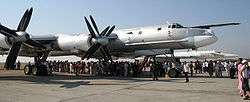Engels-2 (air base)
| Engels-2 | |||||||
|---|---|---|---|---|---|---|---|
| Энгельс-2 | |||||||
| Saratov, Russia in Russia | |||||||
 | |||||||
 | |||||||
 Engels-2 Location of Engels-2 | |||||||
| Coordinates | 51°28′52″N 046°12′38″E / 51.48111°N 46.21056°E | ||||||
| Site information | |||||||
| Owner | Ministry of Defence | ||||||
| Operator | Russian Air Force | ||||||
| Condition | Operational | ||||||
| Site history | |||||||
| Built | 1952 | ||||||
| Built by | Soviet Armed Forces | ||||||
| In use | 1954 - Current | ||||||
| Garrison information | |||||||
| Garrison |
184th Guards Heavy Bomber Aviation Regiment 121st Guards Heavy Bomber Aviation Regiment | ||||||
| Airfield information | |||||||
| Identifiers | IATA: none, ICAO: XWSG | ||||||
| Elevation | 37 metres (121 ft) AMSL | ||||||
| |||||||
Engels Air Force Base (also given as Engels-2 or Engel's) is a strategic military airbase in Russia located 14 kilometres (8.7 mi) east of Saratov. Engels is a major bomber operations base, and is Russia's sole operating location for the Tupolev Tu-160 strategic bombers. The base contains a 3,500 metres (11,500 ft) runway and about 10 large revetments. It is named after the nearby Engels City, which in its turn is named after the Communist philosopher, Friedrich Engels.
History
In 1930, the construction of a military pilots school began 1.5 km from the town of Engels, in a vacant lot. The 14th School of Pilots was activated at Engels on December 15, 1930.[1] Around 10,000 people worked on the site. On February 16, 1932 the first airplane, a Polikarpov U-2 used the site. Reportedly that same day the school was renamed the Engels School of Pilots.[1] By 1936 the Engels military aviation school was one of the best flight schools in the country. Students flew Polikarpov U-2, Polikarpov R-5 and CSS aircraft. Prior to the Second World War the school trained several thousand pilots. Many of them fought in the Spanish Civil War, participated in the Battles of Khalkhin Gol and the Soviet-Finnish War (1939–1940). For participation in the fighting seven pupils were named Heroes of the Soviet Union.
At the beginning of the Second World War the school had in service Polikarpov U-2, ANT-40, Pe-2, and others aircraft. During the war years the Engels Flying School sent to the front 14 regiments. Among them were three women's regiments (including the Night Witches), in which served Major Marina Raskova.[2] 190 pupils of the school were awarded the title of Hero of the Soviet Union for combat exploits.
In the early 1950s, the construction of the new "Engels-2" airport with a concrete runway with a length of 3 km and a width of 100m was begun, and therefore, by September 1954 the Engels school was moved to the city of Tambov. On December 15, 1954, the 201st Heavy Bomber Aviation Division was established, comprising the 79th, 1096th and 1230th Heavy Bomber Aviation Regiments (TBAPs). The personnel of the regiments was assembled by choosing the best specialists of the Long Range Aviation, graduates of military schools and academies.
The first Myasishchev M-4 bombers arrived in Engels on February 28, 1955. In May 1957 the first modernised 3M bomber arrived. In 1957, the 79th Heavy Bomber Aviation Regiment was transferred to Ukrainka and was transferred to the 73rd Heavy Bomber Aviation Division. Gradually the M-4 and 3M bombers were converted into aerial refuelling tankers. Air refueling significantly increased the range of the bombers, which expanded their capacity. Around 1960, the 1230th Heavy Bomber Aviation Regiment was renamed the 1230th Aviation Regiment Air Refueling.[3] The 3M bombers were part of Long Range Aviation until 1985, and then were destroyed in accordance with the agreement on the reduction of offensive weapons. The 3MS-II and 3MN-II, converted into tankers, were in service for much longer – up to the end of 1993 and before being replaced by the more advanced Il-78.
The base was to have received the first production Tu-160 in 1987 but it went to Priluki, whose units had Tupolev Tu-22M experience. The first three Tu-160s not at Pryluky were incorporated into the 1096th Heavy Bomber Aviation Regiment in 1992.[4] By 1994 Engels had five Tu-160 bombers in operation, and that same year the 1096th Heavy Bomber Aviation Regiment was redesignated the 121st Heavy Bomber Aviation Regiment, adopting its colours and traditions. In 1998 the START I treaty exchange of information had shown it had 20 operational Tupolev Tu-95 bombers and six Tu-160 bombers, all with cruise missile capability.
From 1999 to 2001 the base received eight Tu-160s from Ukraine paid for by gas price reductions. The last two arrived on 21 February 2001.[5] The 184th Guards Heavy Bomber Aviation Regiment was reformed at the base on 1 September 2000, drawing on Tu-95MS aircraft transferred from Mozdok.[6] By 2007 the base had 14 Tu-160 bombers, 20 Tu-95 bombers and an unknown number of Tu-22M bombers.
Aircraft
As of 2007, the base had:
- 14 Tupolev Tu-160s (121st Guards Heavy Bomber Aviation Regiment)
- 20 Tupolev Tu-95s (184th Guards Heavy Bomber Aviation Regiment)
- Unknown number of Tupolev Tu-22M-3s (6950th Aviation Base)
- 1 Ilyushin Il-62
The 22nd Guards Heavy Bomber Aviation Division of the 37th Air Army controlled operations at the base up until the Air Force reorganisation of 2009–10.[7]
References
- 1 2 "Tambov Higher Military Aviation School of Pilots". www.ww2.dk. Retrieved 2016-10-27.
- ↑ http://tamanskipolk46.narod.ru/p20aa1.html
- ↑ Butuwski 2004, 84.
- ↑ Butuwski 2004
- ↑ Butowski, Piotr. "Russia's Strategic Bomber Force". Combat Aircraft. 4 (6): 552–565.
- ↑ Butowski 2004, 82.
- ↑ Piotr Butuwski, 'Air Power Analysis: Russian Federation Part 2', International Air Power Review, Summer 2004, 80–81.
External links / further reading
| Wikimedia Commons has media related to Engels_Air_Base. |
- GlobalSecurity.org, Engel's, accessed December 2012.
- "Report on Bomber Elimination at Engels AFB", FBIS Daily Report FBIS-SOV-95-136, 5 July 1995